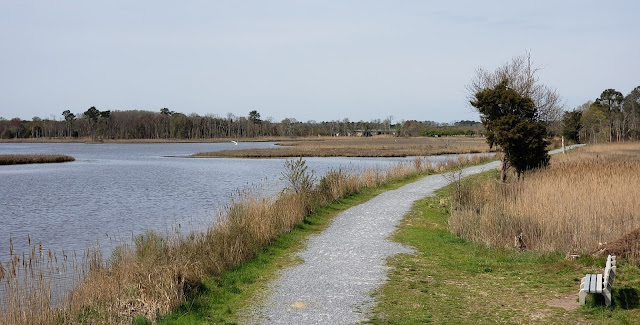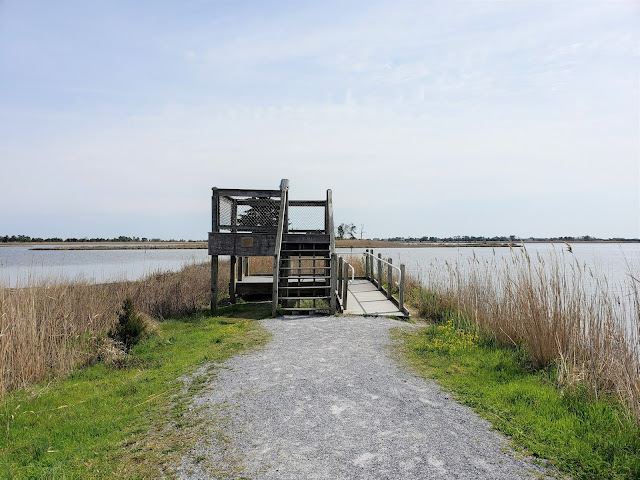Prime Hook National Wildlife Refuge: A Quieter Alternative to Bombay Hook
 |
| An egret takes flight in Prime Hook National Wildlife Refuge |
In April we visited Prime Hook National Wildlife Refuge. Like Bombay Hook National Wildlife Refuge, Prime Hook was established as a sanctuary for migratory birds. Prime Hook is much smaller and quieter than Bombay, making it a more peaceful experience. Unlike Bombay Hook, there’s no fee to visit.
As this map shows, Prime Hook National Wildlife Refuge covers a ten-mile stretch of the Delaware Bayshore. But the refuge does not include the shoreline. The shoreline is occupied by Slaughter Beach, Fowler Beach, Prime Hook Beach, and Broadkill Beach. Those communities were established before Prime Hook National Wildlife Refuge was created in 1963.
There are several access points into the wildlife refuge. The one of interest to most visitors is off Broadkill Beach Road. Take Turkle Pond Road to the visitors center.
 |
| Visitors Center at Prime Hook National Wildlife Refuge |
The visitors center was closed because of the pandemic when we visited. But there are information kiosks, restrooms, and a picnic pavilion.
 |
| Picnic pavilion at Prime Hook |
There’s also a gourd birdhouse.
 |
| Gourd birdhouse at Prime Hook |
Prime Hook has six short walking trails plus a canoe/kayak trail. An online map can help you plan which ones to take. The wildlife refuge has color-coded trail markers that make it easy to find your way. Dogs are permitted on the trails.
 |
| One of Prime Hook's color-coded trail markers |
 |
| Morris Cemetery in Prime Hook |
We saw several great egrets near the Boardwalk Trail.
 |
| Egrets along Prime Hook's Boardwalk Trail |
We then took the Dyke Trail, a half mile each way. It first goes along (surprise!) a dyke that is the Canoe Trail.
 |
| Dyke along Prime Hook's Dyke Trail |
Later on we saw a large black bird that we couldn’t identify.
 |
| A large black bird on the top of the right tree |
The dead trees show how the Delaware Bayshore’s wetlands are changing. The wetlands are largely estuaries, where fresh water from rivers and streams mix with salt water from the bay. As sea levels rise and the land sinks because of something called land subsidence, the water in the estuaries is becoming saltier. Some trees and other plants that once thrived in the estuary can’t survive in the saltier water.
Right alone the Dyke Trail was a tree that I suspect has been damaged by an enthusiastic woodpecker, though I could be wrong!
 |
| Woodpecker damage? |
At the end of the Dyke Trail is a wheelchair-accessible wildlife viewing platform.
 |
| Viewing platform at the end of Prime Hook's Dyke Trail |
From here we saw birds in the water, too far away for us to identify them.
 |
| Birds seen from Prime Hook's viewing platform |
We also saw a kayaker and the houses of Broadkill Beach in the distance.
 |
| Broadkill Beach, seen from Prime Hook |
And of course
we saw another egret!
 |
| Another egret at Prime Hook |
I've mentioned that Prime Hook National Wildlife Refuge doesn’t extend to the Delaware Bay shoreline and that the shoreline is occupied by (from north to south) Slaughter Beach, Fowler Beach, Prime Hook Beach, and Broadkill Beach. I have separate blog posts on Slaughter Beach and Broadkill Beach.
Fowler Beach is a horseshoe crab sanctuary. It’s closed for wildbird nesting from March 1 through October 1, so we were unable to visit it when we stopped by in April. There are no “byway amenities” like restrooms there.
 |
| Fowler Beach entrance, closed from March 1 through October 1 |
Prime Hook Beach is a private community not open to the public.
 |
| Sign at Prime Hook Beach |
I did stop to get a quick photo of the beachfront.
 |
| Prime Hook Beach |
In the middle of Prime Hook National Wildlife Refuge is Prime Hook State Wildlife Management Area. I couldn’t find any information on it, and we didn’t visit it. From the Prime Hook National Wildlife Refuge map, it looks like it offers a boat launch and fishing.



Comments
Post a Comment